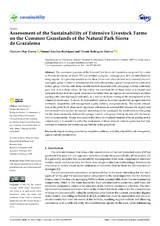Assessment of the Sustainability of Extensive Livestock Farms on the Common Grasslands of the Natural Park Sierra de Grazalema
Autor
Díaz Gaona, Cipriano
Sánchez Rodríguez, M.
Rodríguez-Estévez, V.
Editor
MDPIFecha
2021Materia
Organic farmingEco-schemes
Adaptation
Resilience
Subsidies
Adaptability
Self-management
Equity
Stability
Productivity
METS:
Mostrar el registro METSPREMIS:
Mostrar el registro PREMISMetadatos
Mostrar el registro completo del ítemResumen
The communal pastures of the Natural Park Sierra de Grazalema are grazed by a total of 23 extensive herds, of which 75% are certified as organic, although only 39% are subsidized for being organic. In a previous research work, these farms were characterized and classified into four typologies: group 1 (farms of intermediate size and without sheep), group 2 (large and very extensive farms), group 3 (farms with sheep suitable for both meat and milk) and group 4 (farms with dairy goat milk and without cattle). In this article, the sustainability of these farms is evaluated and compared based on their organic orientation (whether they are organic or conventional) and their typology (the four typologies indicated), as a tool for decision-making in the management of this natural protected area. To do so, 49 sustainability indexes have been generated, grouped into five attributes: adaptability, self-management, equity, stability, and productivity. The results indicate that, at the global level, there are no significant differences in sustainability between the organic and conventional farms studied. In contrast, depending on the typologies, the results indicate that group 3 is the most sustainable, followed by groups 1 and 4, with group 2 being the one with the lowest level of sustainability. Taking into account that there are a reduced number of herds grazing in this natural park, it is essential to solve the weaknesses of these farms in order to guarantee that they continue to maintain environmental equilibrium in the grasslands.

